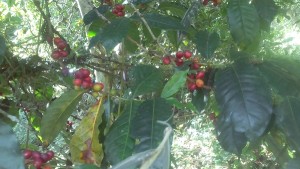 Per cosa e’ famosa la Colombia?
Per tante cose, ma una tra tutte rimanendo nella legalita´: il caffé.
Per un´amante di un buon tinto, come lo chiamano qui, una tappa nella zona caffettera e´ d´obbligo.
L´area e´estesa e variegata ma tra i centri che mi rimangono piu vicini prima di Medellin cé´Salento.
Salento e´un peasetto caratteristico e strategico, perche´mantiene il fascino di un piccolo centro rurale con negozi di artigianato e geográficamente tattico per visitare la Valle de Cocora. Il sabato e domenica si riempie di local che vengono dai centri vicini per fare serata; nella domenica quando sono arrivata trovo nella piazza un super concerto di música rock-ska gratis. Salento mi ha súbito conquistata!
Per cosa e’ famosa la Colombia?
Per tante cose, ma una tra tutte rimanendo nella legalita´: il caffé.
Per un´amante di un buon tinto, come lo chiamano qui, una tappa nella zona caffettera e´ d´obbligo.
L´area e´estesa e variegata ma tra i centri che mi rimangono piu vicini prima di Medellin cé´Salento.
Salento e´un peasetto caratteristico e strategico, perche´mantiene il fascino di un piccolo centro rurale con negozi di artigianato e geográficamente tattico per visitare la Valle de Cocora. Il sabato e domenica si riempie di local che vengono dai centri vicini per fare serata; nella domenica quando sono arrivata trovo nella piazza un super concerto di música rock-ska gratis. Salento mi ha súbito conquistata!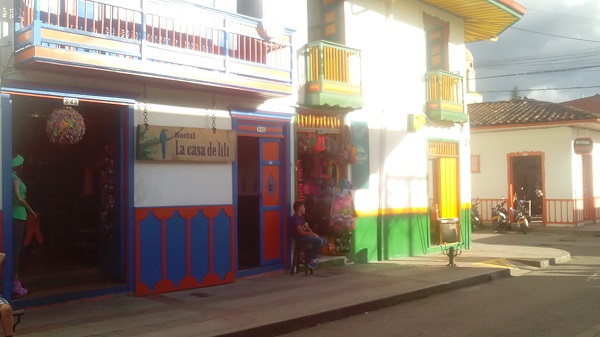 La Valle e´ famosa per gli alberi di palma piu´ alti al mondo: una volta questi venivano usati per la produzione di cera, che veniva grattata via dalla corteccia, ed ora ´intoccabili´ come parte del parco nazionale. La passeggiata nel parco per me inizia alle 7e30 di mattina, quando prendo una jeep con altri escursionisti nella piazza del paese; dopo circa 20 minuti ci scarica davanti all´entrata del parco, tutti e sani e salvi: la jeep era aperta dietro per infilare piu´ persone possibili e calcolando altri 3 in piedi attaccati al tetto.
La Valle e´ famosa per gli alberi di palma piu´ alti al mondo: una volta questi venivano usati per la produzione di cera, che veniva grattata via dalla corteccia, ed ora ´intoccabili´ come parte del parco nazionale. La passeggiata nel parco per me inizia alle 7e30 di mattina, quando prendo una jeep con altri escursionisti nella piazza del paese; dopo circa 20 minuti ci scarica davanti all´entrata del parco, tutti e sani e salvi: la jeep era aperta dietro per infilare piu´ persone possibili e calcolando altri 3 in piedi attaccati al tetto.
 Il sentiero scelto e´ probabilmente di 10km per visitare la casa dei colibrí e salire sulla montagna per poi discendere visitando il versante piu´ bello della vallata.
La passeggiata mi e´ piaciuta, sentivo la necessita´ di un po´ di esercizio immersa nel verde: i sentieri del parco sono tutti marcati, quello per salire alla casa dei colibrí si snoda sinuosamente attraversando il fiume piu´ volte su ponti di legno traballanti o, in maniera tradizionale, su pietre. Non dico nemmeno che, ovviamente, ho lavato le scarpe finendo nell´acqua!
Dopo circa due ore di caminata si arriva in cima alla casa dei colibrí dove ci sono centinaia di piccoli e velocissimi colibrí, accuditi da una familia di locali che vive li. L´entrata e´ di 5000 pesos (circa 2$ americani e meno in euro) per contribuire al mantenimento del parco e come premio per la scalata c´é la scelta tra caffé (ovvio), cioccolato e ´agua panella´ con formaggio. Agua panella é acqua calda con zucchero (panella) servito con formaggio saporito, un accostamento audace che ancora non ho capito.
Il sentiero scelto e´ probabilmente di 10km per visitare la casa dei colibrí e salire sulla montagna per poi discendere visitando il versante piu´ bello della vallata.
La passeggiata mi e´ piaciuta, sentivo la necessita´ di un po´ di esercizio immersa nel verde: i sentieri del parco sono tutti marcati, quello per salire alla casa dei colibrí si snoda sinuosamente attraversando il fiume piu´ volte su ponti di legno traballanti o, in maniera tradizionale, su pietre. Non dico nemmeno che, ovviamente, ho lavato le scarpe finendo nell´acqua!
Dopo circa due ore di caminata si arriva in cima alla casa dei colibrí dove ci sono centinaia di piccoli e velocissimi colibrí, accuditi da una familia di locali che vive li. L´entrata e´ di 5000 pesos (circa 2$ americani e meno in euro) per contribuire al mantenimento del parco e come premio per la scalata c´é la scelta tra caffé (ovvio), cioccolato e ´agua panella´ con formaggio. Agua panella é acqua calda con zucchero (panella) servito con formaggio saporito, un accostamento audace che ancora non ho capito. Il versante della discesa ha ripagato le ore di caminata umida e il fango sui pantaloni: la vallata é super verde con un manto di prato perfetto che copre tutta la superficie, dove spiccano le famose palme altissime. Bella e rilassante questa Valle de Cocora!
Il versante della discesa ha ripagato le ore di caminata umida e il fango sui pantaloni: la vallata é super verde con un manto di prato perfetto che copre tutta la superficie, dove spiccano le famose palme altissime. Bella e rilassante questa Valle de Cocora!
 Nel pomeriggio decido di fare una visita alla piantagione di caffé di proprietá dell´ostello; plantation house é l´ostello e a 500 metri c´é la sua piccola azienda di caffé organico. Mi accompagnano in due ore di passeggiata, dove finalmente vedo le amatissime piante di caffé e ho la possibilitá di partecipare alle diverse fasi di produzione.
William, che accompagna me e un altro ragazzo spagnolo nella visita, ci spiega il perché di tante cose, e ci fa vedere come operano i 5 operai fissi per il mantenimento della terra e cura delle piante. I pochi operai vengono incrementati nel periodi di raccolta (aprile-maggio e ottobre-novembre), ma per la maggior parte del tempo sono solo loro; in questa finca la raccolta, come tutto il resto, é manuale. Nulla da dire ma la piantagione non é cosi piccola e il terreno é tutto in discesa, ho i brividi al pensiero della fatica!
La piantagione é bella perché ci sono tante piante di frutta che servono a proteggere le piante di caffé, tra tutte spiacca un albero di avocado di 25 metri… WOW!
Curiositá:
Tutto il caffé colombiano viene raccolto dalla compagnia Juan Valdéz che poi lo smercia all´estero. Solo il 40% del profitto va ai produttori.
Nel pomeriggio decido di fare una visita alla piantagione di caffé di proprietá dell´ostello; plantation house é l´ostello e a 500 metri c´é la sua piccola azienda di caffé organico. Mi accompagnano in due ore di passeggiata, dove finalmente vedo le amatissime piante di caffé e ho la possibilitá di partecipare alle diverse fasi di produzione.
William, che accompagna me e un altro ragazzo spagnolo nella visita, ci spiega il perché di tante cose, e ci fa vedere come operano i 5 operai fissi per il mantenimento della terra e cura delle piante. I pochi operai vengono incrementati nel periodi di raccolta (aprile-maggio e ottobre-novembre), ma per la maggior parte del tempo sono solo loro; in questa finca la raccolta, come tutto il resto, é manuale. Nulla da dire ma la piantagione non é cosi piccola e il terreno é tutto in discesa, ho i brividi al pensiero della fatica!
La piantagione é bella perché ci sono tante piante di frutta che servono a proteggere le piante di caffé, tra tutte spiacca un albero di avocado di 25 metri… WOW!
Curiositá:
Tutto il caffé colombiano viene raccolto dalla compagnia Juan Valdéz che poi lo smercia all´estero. Solo il 40% del profitto va ai produttori.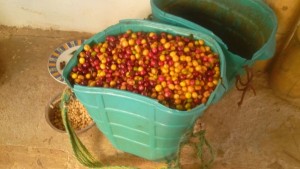 Il miglior caffé colombiano viene venduto all´estero, la seconda qualitá rimane nel paese. Quindi amici se volete il caffé buono cómpratelo vicino casa 😉
Il miglior caffé colombiano viene venduto all´estero, la seconda qualitá rimane nel paese. Quindi amici se volete il caffé buono cómpratelo vicino casa 😉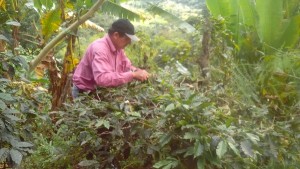 Nella tostatura, piú il chicco si cuoce piú perde umiditá quindi:
- cotto + caffeina = caffé suave,
+ cotto - caffeina = caffé amaro.
Nella tostatura, piú il chicco si cuoce piú perde umiditá quindi:
- cotto + caffeina = caffé suave,
+ cotto - caffeina = caffé amaro. In Colombia si raccoglie dalla pianta prevalentemente, mentre in Brasile si lascia maturare di piú sulla pianta e si raccoglie macchinalmente scuotendo la pianta.
In Colombia si raccoglie dalla pianta prevalentemente, mentre in Brasile si lascia maturare di piú sulla pianta e si raccoglie macchinalmente scuotendo la pianta.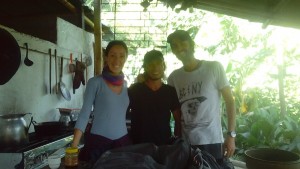 Quante strati di buccia ha un chicco di caffé? Tante.
Quante strati di buccia ha un chicco di caffé? Tante.
La zona cäfetera – Salento
 For what is famous Colombia?
For many things, but one of all, remaining in legality: the coffee.
For a lover of a good ´tinto´, as they call it here , a step in the caffettera area is a must.
The area is extended and varied but among all towns before Medellin, there is Salento.
Salento is a typical small and strategic town as it keeps the charm of a small rural town with craft shops and geographically tactical for visiting the Valle de Cocora. On Saturday and Sunday it is filled with locals from the close villages that come here for the the evenings; on Sunday when I arrived, I find a super concert of rock – ska music for free in the main plaza. Salento conquered me immediately!
For what is famous Colombia?
For many things, but one of all, remaining in legality: the coffee.
For a lover of a good ´tinto´, as they call it here , a step in the caffettera area is a must.
The area is extended and varied but among all towns before Medellin, there is Salento.
Salento is a typical small and strategic town as it keeps the charm of a small rural town with craft shops and geographically tactical for visiting the Valle de Cocora. On Saturday and Sunday it is filled with locals from the close villages that come here for the the evenings; on Sunday when I arrived, I find a super concert of rock – ska music for free in the main plaza. Salento conquered me immediately!
 The Valley is famous for the highest palm trees in the world: once these were used for the production of wax, which was scraped off the bark, and now they are 'untouchable' as part of the national park. The walk in the park for me started at 7e30am, when I took a jeep with other hikers from the square; after about 20 minutes we arrived at the entrance of the park, all safe and sound: the jeep was open behind to fit more people and having other 3 pp standing behind attached to the jeep roof.
The Valley is famous for the highest palm trees in the world: once these were used for the production of wax, which was scraped off the bark, and now they are 'untouchable' as part of the national park. The walk in the park for me started at 7e30am, when I took a jeep with other hikers from the square; after about 20 minutes we arrived at the entrance of the park, all safe and sound: the jeep was open behind to fit more people and having other 3 pp standing behind attached to the jeep roof.
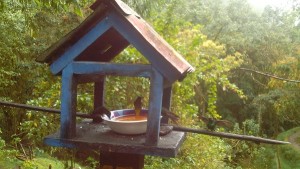 The path chosen probably was 10km to visit the home of the hummingbird and go up the mountain and then descend by visiting the most beautiful side of the valley.
I liked the walk as I needed a bit of exercise immersed in the green: the park trails are all marked, that one to go up to the house of hummingbird winds sinuously across the river crossing it few times on rickety wooden bridges or, in the traditional way, on stones. I don´t need to say that, of course, have washed your shoes ending up in the water!
The path chosen probably was 10km to visit the home of the hummingbird and go up the mountain and then descend by visiting the most beautiful side of the valley.
I liked the walk as I needed a bit of exercise immersed in the green: the park trails are all marked, that one to go up to the house of hummingbird winds sinuously across the river crossing it few times on rickety wooden bridges or, in the traditional way, on stones. I don´t need to say that, of course, have washed your shoes ending up in the water!
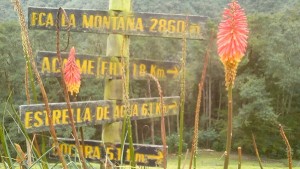 After about two hours walking I reached the house of hummingbirds where there are hundreds of small and fast hummingbirds, looked after by a local family that lives there. The entrance was 5000 pesos (about US$2 and less in euro) to contribute to the maintenance of the park and as a reward for the climb there is a choice of coffee (of course), chocolate and 'agua panella' with cheese. Agua panella is hot water with sugar (Panella) served with tasty cheese, a bold approach that still I don´t understand.
The slope of the descent has repaid hours of walking under the rain and mud on the pants: the valley is super green with a blanket of perfect lawn that covers the entire surface, where the famous towering palms stand. Beautiful and relaxing this Valle de Cocora!
After about two hours walking I reached the house of hummingbirds where there are hundreds of small and fast hummingbirds, looked after by a local family that lives there. The entrance was 5000 pesos (about US$2 and less in euro) to contribute to the maintenance of the park and as a reward for the climb there is a choice of coffee (of course), chocolate and 'agua panella' with cheese. Agua panella is hot water with sugar (Panella) served with tasty cheese, a bold approach that still I don´t understand.
The slope of the descent has repaid hours of walking under the rain and mud on the pants: the valley is super green with a blanket of perfect lawn that covers the entire surface, where the famous towering palms stand. Beautiful and relaxing this Valle de Cocora!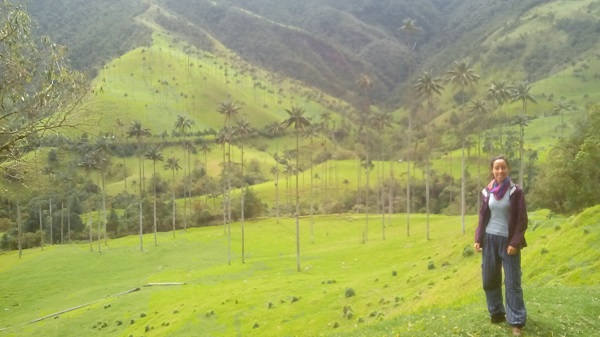 In the afternoon I decided to pay a visit to the coffee plantation of the hostel property; plantation house is the hostel and at 500 meters there is its small company of organic coffee. They took me in a two-hour walk, where I finally saw the beloved plants of coffee and I had the opportunity to participate in various stages of the production.
In the afternoon I decided to pay a visit to the coffee plantation of the hostel property; plantation house is the hostel and at 500 meters there is its small company of organic coffee. They took me in a two-hour walk, where I finally saw the beloved plants of coffee and I had the opportunity to participate in various stages of the production.
 William, who accompanied me and another Spanish guy, explained the reason of many things, and shown us how the five workers to operate for maintaining the land and taking care of the plants. The few workers are increased in the harvest (April-May and October-November), but for most of the time they are alone. The picking in the finca, like everything else, is manual. Nothing to say, but the plantation is not so small and the land is all downhill, I shivered at the thought of the fatigue!
The plantation is beautiful because there are many fruit trees that serve to protect the plants of coffee, including all, it stands out an avocado tree of 25 meters ... WOW!
Curiosities:
William, who accompanied me and another Spanish guy, explained the reason of many things, and shown us how the five workers to operate for maintaining the land and taking care of the plants. The few workers are increased in the harvest (April-May and October-November), but for most of the time they are alone. The picking in the finca, like everything else, is manual. Nothing to say, but the plantation is not so small and the land is all downhill, I shivered at the thought of the fatigue!
The plantation is beautiful because there are many fruit trees that serve to protect the plants of coffee, including all, it stands out an avocado tree of 25 meters ... WOW!
Curiosities:
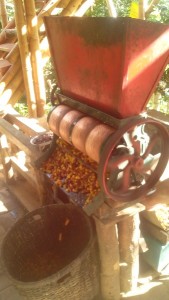 All Colombian coffee is collected by the company Juan Valdéz who then sells it abroad. Only 40% of the profit goes to the producers.
The best Colombian coffee is sold overseas, the second quality coffee stays in the country. So friends, if you want good coffee buy it close to home 😉
When roasting, more the grain is cooked more it loses the humidity then:
- Cooked + Caffeine = mild coffee,
+ Cooked - Caffeine = bitter coffee.
In Colombia, the coffee is collected from the plant mainly, while in Brazil it is left to mature on the plants and harvested mechanically shaking the plant itself.
How many layers of skin has a coffee bean? Many.
All Colombian coffee is collected by the company Juan Valdéz who then sells it abroad. Only 40% of the profit goes to the producers.
The best Colombian coffee is sold overseas, the second quality coffee stays in the country. So friends, if you want good coffee buy it close to home 😉
When roasting, more the grain is cooked more it loses the humidity then:
- Cooked + Caffeine = mild coffee,
+ Cooked - Caffeine = bitter coffee.
In Colombia, the coffee is collected from the plant mainly, while in Brazil it is left to mature on the plants and harvested mechanically shaking the plant itself.
How many layers of skin has a coffee bean? Many. 